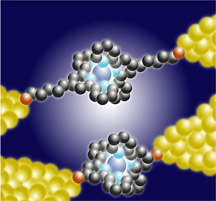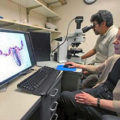
A long-sought goal of scientists has been to shrink the transistor, the basic building block of electronic circuits, to smaller and smaller size scales. Scientists at Cornell University have now reached the smallest possible limit: a transistor in which electrons flow through a single atom.
The Cornell researchers have created a single-atom transistor by implanting a “designer” molecule between two gold electrodes, or wires, to create a circuit. When voltage was applied to the transistor, electrons flowed through a single cobalt atom within the molecule. Paul McEuen, professor of physics at Cornell, describes the process by which electrons pass from one electrode to the other by hopping on and off the atom as “a virtual dance of electrons.”
McEuen and his colleagues at Cornell’s Center for Materials Research, including Dan Ralph, associate professor of physics, and graduate students Jiwoong Park and Abhay Pasupathy, report on their creation of a single-atom transistor in the latest issue (June 13) of the journal Nature .
McEuen cautions that the device cannot yet be described as having all the functions of a traditional transistor, such as amplification. But he sees a potential application for the new transistor as a chemical sensor because a change in the environment around the molecule could cause a measurable alteration of the conductance of the device.
The challenge faced by the Cornell researchers was to place a molecule less than two nanometers long (about the length of five silicon atoms) between two gold electrodes. To do this they used a technique called electromigration, by which an increasingly large current is run through a gold wire, forcing the atoms to migrate until the wire breaks. The molecule is then “sucked” into the gap by the high electric field present, and the sulfur “sticky fingers” bond the molecule to the gold. “Using this technique you can very reliably get wires with a gap on the order of one nanometer,” or about three silicon atoms, says McEuen.
The technique was invented by McEuen and his former postdoctoral colleague, Hongkun Park, when both were researchers at the University of California-Berkeley. Park, now at Harvard University, reports in the same issue of Nature on a similar development in molecular electronics, using a different molecule. Both teams were able to start and stop the flow of electrical current by adjusting the voltage near the bridging molecule.
Although the single-atom transistor demonstrates the potential for shrinking the size of components well beyond what is possible using conventional lithographic techniques, says McEuen, there are major technological hurdles to be overcome in order to build such a transistor for electronic applications. One problem to be solved, for example, is gain, the ability to amplify a small signal.
The Cornell group plans next to focus on engineering a molecule with two different geometries (or shapes) that could act as a switch, changing between the two forms with the application of a voltage. “No one has yet put a single molecule in a circuit and activated it electronically,” McEuen observes.
(pic courtesy Cornell University)


















Comments are closed.